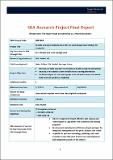| Abstract | a) Issue:
The greyback canegrub (Dermolepida albohirtum) is the main pest of cane crops in all canegrowing regions from Mossman to Sarina. Infestations by this pest species may cost the industry up to 40 million dollars in years of high infestations. Other grub species also cause considerable damage in Southern Queensland. Canegrubs feed on the root mass of sugarcane plants reducing plant vigour and yield. Due to the annual life cycle of these pests, it is usually too late to apply pesticides to the crop by the time damage symptoms become apparent. In addition, grub numbers usually build up and initially remain unnoticed until an economical threshold is reached, at which time control measures become too costly or too late to implement. Hence, timely monitoring and early warning techniques need to be implemented to reduce the chances of pest outbreaks. Conventional field sampling is a time-consuming and strenuous task, hence, remote sensing/satellite imagery techniques may be implemented for timely damage detection and to provide advice to growers accordingly. Satellite images therefore were sourced for each participating region in the project (FNQ, Burdekin and Central district and Southern district). Geographic Object Based Image Analysis (GEOBIA) and the highly advanced “eCognition” software were used for image analysis. Based on the mapping results we then compiled grub damage risk maps which were communicated to growers.
b) R&D Methodology:
After a satellite image is taken for a region it is first pre-processed to correct for radiometric and geometric effects and then analyzed using GEOBIA to automatically identify areas with canegrub damage. We developed four key steps to conduct the analysis: (1) initial segmentation of block boundaries and further segmentation of each block into smaller homogenous objects; (2) classification and subsequent omission of fallow/harvested fields, tracks and other non-sugarcane features; (3) identification of potentially grub-damaged areas within each block with the lowest amounts of green leaves (low Normalised Difference Vegetation Index (NDVI) values) and highest level of image texture and (4) further refining of ‘potentially’ grub damaged areas into low, medium or high likelihood of an area being affected. This is based on the absolute difference in the amount of green leaves (NDVI values) and texture between ‘potentially’ grub damaged areas and the remaining parts of each block. Areas suspected of sustaining grub damage based on the analysis are then visited for “ground-truthing”. A flight is also conducted to facilitate better examination of any apparent disorder. A ground-truthed map can then be produced and communicated to growers. False positives and false negatives are noted to further improve detection accuracy. We conducted several GrubPlan workshops across Queensland which were attended by growers, Productivity Service and mill staff members. The project has been very well received by the industry.
c) The project deliverables
We developed an eCognition rule set for classifying grub damage using satellite images. We also developed the capacity to produce accurate grub damage risk maps. Our validation work yielded overall damage detection accuracies of up to 90% or higher in several cases, however, this included a number of false positives resulting from sprawling, water logging, weed and pig damage. Our damage detection accuracy can only improve as more work is conducted and more data are fed to the model. The technology is now at a stage where it can be implemented by the industry.
d) The outcomes and impact of the project findings on the sugar industry and the Australian
community.
The project addressed the “Pest, disease and weed management” key focus area, and we believe the following measures of success have been recognized: Industry supported through effective pest, disease and weed diagnostic capabilities and awareness and training programs. Development and adoption of SRA-developed packages for integrated management of key pests, diseases and weeds. Capability to provide entomology, pathology and weed expertise to meet the pest, disease and weed diagnostic and management needs of the industry. These criteria have been achieved through direct communication of results to Mulgrave, Burdekin, Mackay, Bundaberg and Isis industry members. We conducted several GrubPlan workshops in most areas where we communicated the results and distributed risk maps to growers and millers. During these workshops, Integrated Pest Management concepts were addressed as an all-encompassing approach to grub control and general crop health instead of only relying on pesticides. In addition, several other observations can be made via the use of a satellite image as general crop condition and potential yield could also be estimated. Currently the capacity of delivering a digital risk map to be accessed through Google Earth or the mill website is available. Most growers welcomed the information they received and expressed interest in maintaining this work. We have been in consultation with several canegrowers and Productivity Service staff across Queensland. Through these discussions, a clear image on the advisory service style required has emerged, and we are now able to produce accurate grub risk maps and provide advice on general crop condition to participating growers/mill regions according to their need. A subsequent “industry implementation” phase of the project is ready to be rolled out in certain regions where industry members are willing to support this work financially. |

